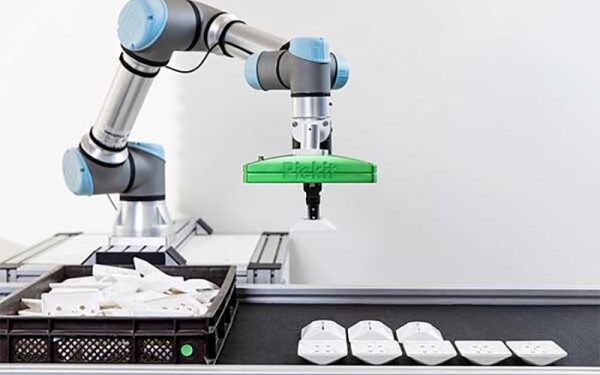Automating Complex Material Handling
In many manufacturing and logistics environments, one of the most deceptively difficult tasks is picking up unsorted parts or products from bins and transferring them to machines or conveyors. Known as “bin picking,” this task is simple for humans but highly complex for robots. Today, robotic bin picking systems equipped with advanced 3D vision and smart algorithms are bridging that gap, bringing automation to previously manual zones of the factory.
What Is Robotic Bin Picking?
Robotic bin picking refers to the use of a robotic arm, paired with a 3D vision system, to identify, locate, and retrieve randomly oriented parts from a bin or tote. Unlike traditional pick-and-place systems that rely on precise positioning, bin picking deals with unstructured environments parts may be piled, overlapping, or partially obscured.
A typical bin picking system includes:
- A 6-axis industrial robot
- A 3D vision system (structured light, stereo cameras, or laser scanners)
- A software engine to interpret visual data and plan the pick
- An appropriate gripper (suction, mechanical, adaptive)
- Communication with downstream machines or conveyors
Once a target object is identified and its position calculated, the robot adjusts its path and orientation in real-time to grasp and remove it.

The Impact of Robotic Bin Picking in Industry
Robotic bin picking systems are unlocking new levels of automation in areas that were once bottlenecks or labour-intensive tasks.
Labor Reduction in Repetitive Tasks
Traditionally, human workers have been tasked with pulling parts from bins for sorting, assembly, or machining. These repetitive tasks are prone to fatigue, inconsistent pace, and ergonomic strain. Robotic systems can work continuously and predictably freeing up human labour for more skilled activities.
Improved Consistency and Speed
Unlike manual operators, robotic bin picking systems operate at a consistent speed without variation or rest. They also don’t rely on tribal knowledge or experience to locate parts efficiently vision algorithms do the heavy lifting. This improves cycle time and reduces scrap from mishandled components.
Intelligent 3D Vision
Modern bin picking relies heavily on high-resolution 3D cameras and powerful processors. These systems capture the depth, shape, and orientation of objects, even when partially hidden or stacked irregularly. AI-enhanced software can learn to recognize different part types, skip unpickable items, or prioritize based on shape, size, or order.
Flexible Part Handling
A well-designed bin picking system can handle a variety of part types without major reprogramming. With tool changers or adaptive grippers, a single robot can switch between handling metal castings, plastic enclosures, fasteners, or soft packaging. This flexibility makes it ideal for high-mix, low-volume operations.
Seamless Integration
Bin picking robots are often integrated upstream of machines like CNCs, conveyors, or assembly cells. Their outputs are synchronized via PLCs or industrial networks, allowing fully automated workflows from part retrieval to processing. Sensors confirm part presence and location, reducing jams and errors.
Real-World Applications
- Automotive: Picking randomly oriented engine parts or fasteners from bins for assembly
- Injection Moulding: Extracting moulded components from bins and feeding them to trimming stations
- Metal Casting: Handling rough castings for deburring, machining, or quality inspection
- E-Commerce Warehousing: Sorting and handling unboxed items of varied shapes and materials
- Electronics: Selecting components from bulk storage for precision placement or packaging
These examples demonstrate the system’s ability to tackle real-world complexity at speed and scale.
Key Components of a Successful Bin Picking System
- 3D Camera: Provides depth data and accurate object shape information
- Vision Software: Locates parts, calculates optimal grip points, and avoids collisions
- Robot Arm: Executes the pick with smooth motion and adaptive control
- Gripper: Matches the part’s shape and weight—can be suction-based or mechanical
- Safety Systems: Includes light curtains, safety scanners, or interlocks to ensure safe operation.
Each element must be carefully selected and tuned for the type of material, part geometry, and desired cycle time.
Scalability and Modularity
Bin picking solutions are increasingly modular cameras, software, and robots can be configured and scaled depending on the task. Multiple picking stations can work in parallel, or mobile robots can carry bins to and from fixed arms. This enables scalable automation with minimal disruption to existing layouts.
Robotic bin picking transforms one of the most variable and labour-intensive processes into a fast, reliable, and intelligent system. By combining advanced 3D vision, adaptive gripping, and powerful motion control, bin picking solutions are enabling factories and warehouses to close the automation loop from part delivery to processing. As vision algorithms and robotic dexterity continue to advance, bin picking will play a growing role in the future of flexible, lights-out manufacturing.
